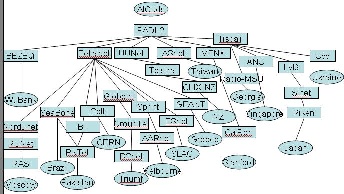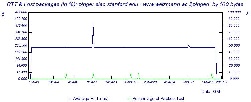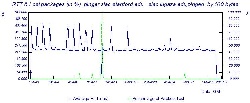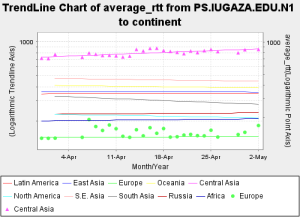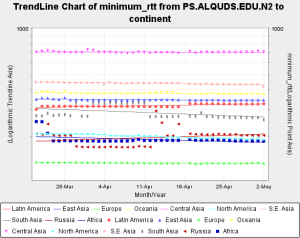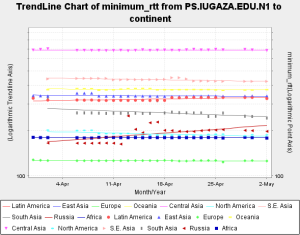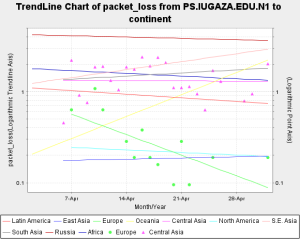By Les Cottrell and Shahryar Khan
Installations
In March and April 2007 we worked with people from Palestine and the University at Buffalo to install PingER Measurement Points (MPs) in Al Quds University (AQU) in Abu Dis on the West Bank and the Islamic University of Gaza (IUG) in Gaza City. They were both connected to the Mediterranean fibre optic cable though at first the host used at AQU was routed through Barak an Israeli commercial Internet porovider. There is a probability the Palestinian hosts will lose their connection to the Mediterranean fibre optic cable in Summer 2007.
AQU successfully installed PingER without help. It has been measuring and reporting since March 23, 2007. It has been very reliable with few losses of data.
Warren Matthews of Georgia Tech stepped in and assist IUGaza in getting PingER2 running. There were problems with the cronjob and possibly ntpd. IUG has been monitoring successfully since April 7th, 2007. They did not monitor data all day on April 22. There have been problems on 2 days gathering the data where I have either contacted the IUGaza site contact (Apr 28th to fix the web server) or had to re-run the gathering script. It was having problems again on May 3-7, 2007 and has been reported to the contact.
On April 3rd the Al-Quds Open University (OAU) in Ramallah said they would prepare a new machine and install software. I responded on April 4th and April 17th, but have heard nothing since. I prompted them again 5/4/07 and 5/9/07.
The locations of the sites are shown below.
Pinger Coverage
| Include Page | ||||
|---|---|---|---|---|
|
Worldwide Comparison
| Include Page | ||||
|---|---|---|---|---|
|
MOS for various Regions
| Include Page | ||||
|---|---|---|---|---|
|
TCP throughput from CERN & SLAC to World Regions
| Include Page | ||||
|---|---|---|---|---|
|
Palestine
Routes
The main Autonomous System (AS) domains in the routes from SLAC to the Middle East countries for the sites we monitor are shown in the figure to the left below. It can be seen that many providers are used. Al Quds connects to PADI2. The Palestinian sites (Gaza and the West Bank) use different providers from each other and from the neighboring countries. The figure on the right shows the ASs used to route from AQU to various countries of the world.
Routes Al Quds University to Middle East Countries
All routes from Al-Quds University (Palestine, West Bank) except to OAU go via Israel. Al-Quds is connected to OAU via PADI2 with an E1 link from Al-Quds. There are three hops all in the PADI2 ASN and the distance is a << 100 miles. The link is heavily congested during work hours. However, even when 25% congested the traceroute measured from Al-Quds University is close to 90 ms. This maybe due asymmetric routing
Routes to other than OAU and the Islamic University of Gaza also usually go via Europe to other Middle Eastern Countries.
The route from Al-Quds (Palestine West Bank) to Cyprus goes via Israel, Europe, United Kingdom.
The route to Iran goes via Israel, Europe, Turkey and then reaches Iran.
From Al-Quds to Jordan goes via Israel, US (Kansas), France and then reaches Jordan.
From West Bank to Gaza goes via Israel.
To Turkey goes via Israel, Europe and then reaches Turkey.
From Palestine to UAE goes via Israel, Europe, UK and then goes to Dubai.
From Palestine to Oman goes via Israel, Germany, Italy and then reaches Oman.
Here is a map of connectivity from Al Quds to other Middle East Countries.
Routes Al Quds University to Other Countries
Palestine to China: Palestine->Israel->Germany->Japan->China;
Palestine to US*:* Palestine-> Israel -> Europe-> US (California);
Palestine to New Zealand: Palestine -> Israel -> US (Florida) -> US (Kansas) -> US (New Mexico) -> New Zeland;
Palestine to Australia: Palestine-> Israel ->Europe -> US(Kansas) -> Australia;
Palestine to Russia: Palestine -> Israel -> Germany -> Russia(Moscow);
Palestine to Pakistan: Palestine -> Israel -> Europe -> Italy -> Pakistan;
Palestine to Greece: Palestine -> Israel -> Europe -> United Kingdom -> Greece;
Palestine to Taiwan: Palestine -> Israel -> US (Kansas) -> Tiawan;
Palestine to India: Palestine -> Israel -> Germany -> Netherlands -> United Kingdom -> India;
Palestine to Chile: Palestine -> Israel ->Germany -> US -> Mexico -> Chile;
Palestine to Argentina: Palestine -> Israel -> Europe -> US (Kansas) -> US (Texas) -> Argentina;
Palestine to Switzerland: Palestine -> Israel -> Europe -> United Kingdom -> Switzerland;
Palestine to Egypt: Palestine -> Israel -> Germany -> Netherlands -> United Kingdom -> Egypt.
Round Trip Times, Losses and Througputs for Palestine with Various Regions
The hourly losses and RTTs seen from SLAC for Israel, Al Quds and IUGaza are shown below. It is seen that israel has almost no variability so the link is un-congested. Both the Al Quds and IUGaza time series show strong diurnal changes indication congestion/queuing during work hours. Comparing Al Quds and IUGaza it appears they have similar minimum RTTs of about 250ms. IUGaza has improved with less congestion since April 17, 2007. Al Quds had two periods of unreachability (100% loss on the green line).
The fallowing graph shows the daily TCP throughput seen from SLAC to Al Quds University, IUGaza and the Palestine Standards Institution (www.psi.gov.ps). It can be seen that the performance is very variable, probably due to diurnal congestion. In addition IUGaza and the Palestinian Standards Institution have similar derived throughput, whil Al-Quds University is lower.
The monthly average Round Trip Times (RTTs) from Al Quds and IUGaza are shown below. The individual data points daily avergae(average_RTT) are shown to show the variability.
The minimum RTTs are shown below with the individual points (since minimum RTTs are more stable).
The packets losses are shown below:


